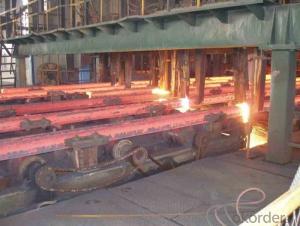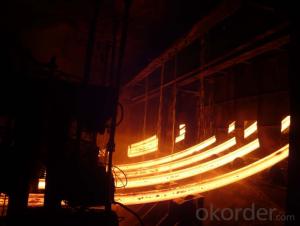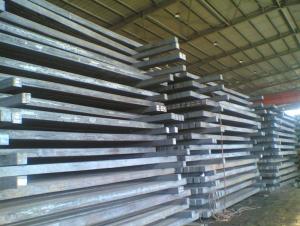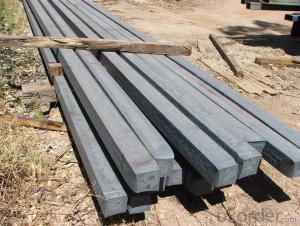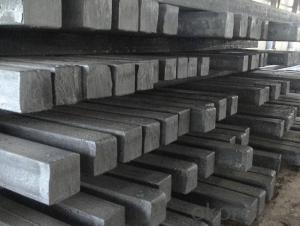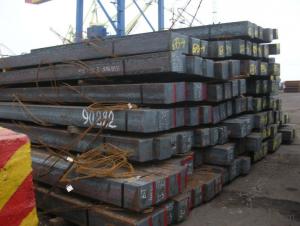Hot Rolled Square Steel Billet 3SP Standard 170mm
- Loading Port:
- Shanghai
- Payment Terms:
- TT OR LC
- Min Order Qty:
- 2000 m.t.
- Supply Capability:
- 10000 m.t./month
OKorder Service Pledge
OKorder Financial Service
You Might Also Like
Structure of Hot Rolled Square Steel Billet 3SP Standard 170mm

Description of Hot Rolled Square Steel Billet 3SP Standard 170mm
PPGI is made by cold rolled steel sheet and galvanized steel sheets as baseplate, through the surface pretreatment (degreasing, cleaning, chemical conversion processing), coated by the method of continuous coatings (roller coating method),
and after roasting and cooling. Zinc coating: Z60, Z80, Z100, Z120, Z180, Z275, G30, G60, G90
Alu-zinc coating: AZ60, AZ80, AZ100, AZ120, AZ180, G30, G60, G90
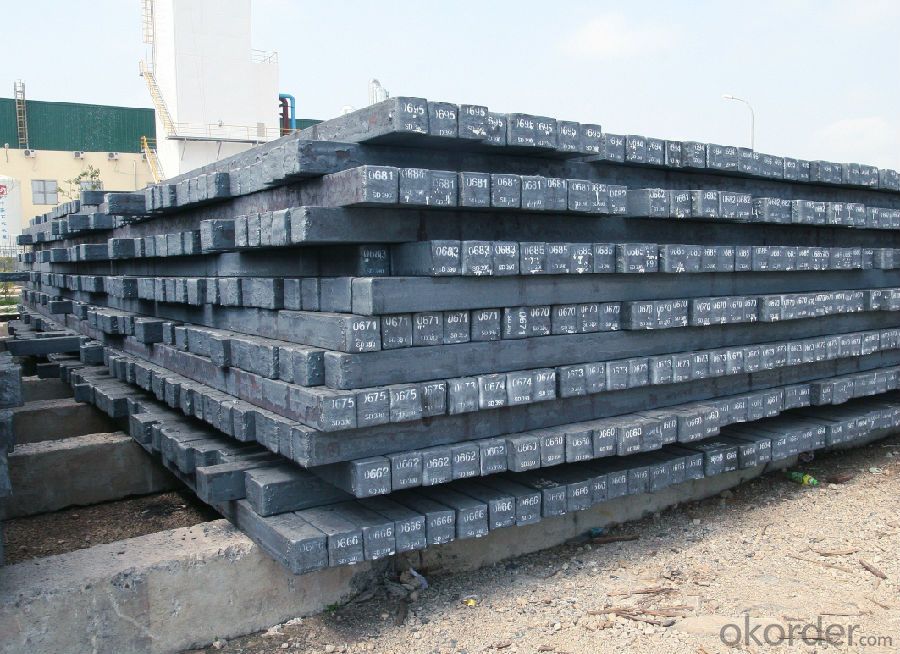
Main Feature of Hot Rolled Square Steel Billet 3SP Standard 170mm
1) Excellent corrosion resistance: The zinc layer provides a good protection of Pre-painted Galvanizeed Steel Sheet.
2) High heat resistance: The reflective surface of the material aids in efficiently reflecting the sunlight away and in turn reducing the amount of heat transmitted. The thermal reflectivity converts into energy savings.
3) Aesthetics: Pre-Painted Galvanized steel sheet is available in plethora of patterns and multiple sizes as per the requirements that given by our customers.
4) Versatility: can be used in the various areas.Standard seaworthy export packing: 3 layers of packing, inside is kraft paper, water plastic film is in the middle and outside GI steel sheet to be covered by steel strips with lock, with inner coil sleeve.
Applications of Hot Rolled Square Steel Billet 3SP Standard 170mm
1) Automotive bodies: filters, fuel tanks, etc.
2) Construction materials: roofings, welding pipes,
3) Electric and electronic appliances: computer cans, etc.
4) Steel cans: containers, etc.
5) Steel furniture: washing machines, refrigerators, microwaves, etc.
6) Drums
7) Office equipment: printer, recorders, etc.
8) Motors and transformers
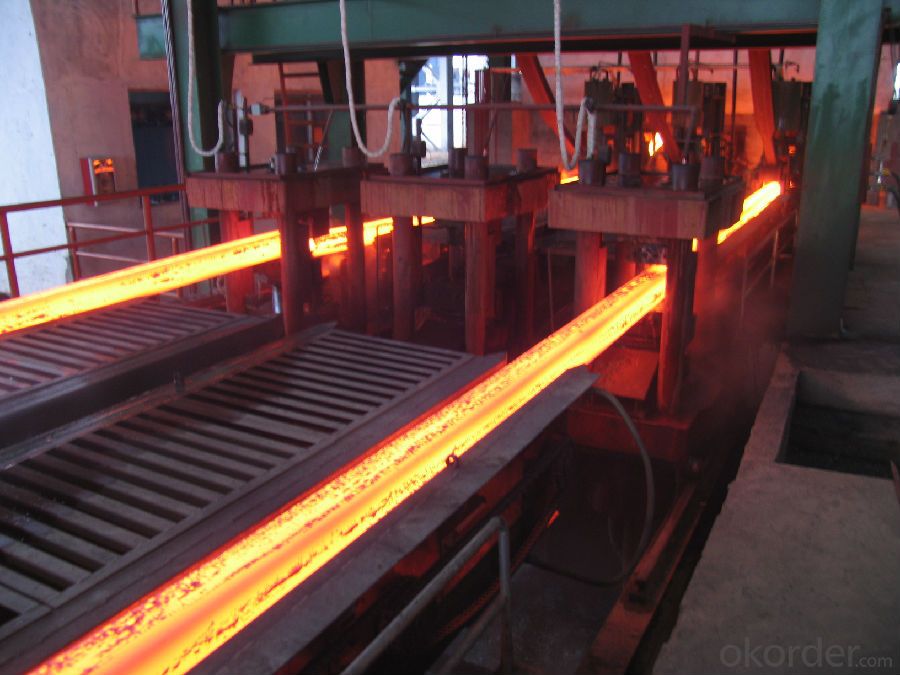
Specifications of Hot Rolled Square Steel Billet 3SP Standard 170mm
| Classified symbol | Yield Point Minimum N/mm2 | Tensile Strength Minimum | Elongation Minimum % | Application | ||||
| N/mm2 | Nominal Thickness mm (t) | |||||||
| JIS | Yogic | 0.25-0.4 | 0.4-0.6 | 0.6-1.0 | 1.0-1.6 | |||
| G3312 | specification | |||||||
| CGCC | CGCC | -205 | -270 | -20 | -21 | -24 | -24 | Commercial |
| CGCD | CGCD | --- | 270 | --- | 27 | 31 | 32 | Drawing |
| --- | CG340 | 245 | 340 | 20 | 20 | 20 | 20 | Structural |
| CGC400 | CG400 | 295 | 400 | 16 | 17 | 18 | 18 | Structural |
| CGC440 | CG440 | 335 | 440 | 14 | 15 | 16 | 18 | Structural |
| CGC490 | CG490 | 365 | 490 | 12 | 13 | 14 | 16 | Structural |
| CGC570 | CG570 | 560 | 570 | --- | --- | --- | --- | Structural |
| ASTM Designation | Yield Point Minimum | Tensile Strength Minimum | Elongation Minimum % | Application | Q/BQB 445-2004(China standard) | ASM A653/A653M | JISG 3312 | |
| ksi(MPa) | ksi(MPa) | TDC51D+Z | (CS TYPE A+Z) | CGCC | ||||
| A653(M)-99 CS TYPE A,B,C | --- | --- | --- | Commercial | TDC52D+Z | CGCD | ||
| A653(M)-99 FS | --- | --- | --- | Lock Forming | TS250GD+Z | (G250+Z) | - | |
| A653(M)-99 DS | --- | --- | --- | Drawing | TS300GS+Z | (G300+Z) | CGC 400 | |
| A653(M)-99 SS Grade33(230) | 33(230) | 45(310) | 20 | Structural | TS350GD+Z | (G350+Z) | CGC490 | |
| A653(M)-99 SS Grade37(255) | 37(255) | 52(360) | 18 | Structural | TS550GD+Z | (G550+Z) | CGC570 | |
| A653(M)-99 SS Grade40(275) | 40(275) | 55(380) | 16 | Structural | ||||
| A653(M)-99 SS Grade50(345) | 50(345) | 65(450) | 12 | Structural | ||||
| A653(M)-99 SS Grade80(550) | 80(550) | 82(570) | --- | Structural | ||||
FAQ of Hot Rolled Square Steel Billet 3SP Standard 170mm
We have organized several common questions for our clients,may help you sincerely:
1. How Can I Visit There?
Our company is located in Tianjin City, China, near Beijing. You can fly to Tianjin Airport Directly. All our clients, from home or aboard, are warmly welcome to visit us!
2. How Can I Get Some Sample?
We are honored to offer you sample.
3. Why choose CNBM?
1, ISO, BV, CE, SGS approved.
2, Competitive price and quality.
3, Efficient service team online for 24 hours.
4, Smooth production ability(50000tons/month) .
5, quick delivery and standard exporting package.
6, Flexible payment with T/T, L/C, Paypal, Kunlun bank, etc.
- Q:What is the role of steel billets in the construction of high-rise buildings?
- Steel billets play a vital role in the construction of tall buildings, serving as the raw material for structural components like beams, columns, and girders. Their exceptional strength and durability make them ideal for supporting heavy loads and resisting external forces such as wind and earthquakes. Furthermore, steel billets offer design and construction flexibility, allowing architects and engineers to create intricate and visually appealing structures. Their versatility also enables the construction of large spans, reducing the need for excessive supporting columns and maximizing usable space. In addition, steel billets are highly resistant to corrosion and fire, ensuring the longevity and safety of skyscrapers. The galvanized or coated surface protects against rust, while the fire-resistant properties of steel maintain its strength at high temperatures. Moreover, steel billets contribute to the sustainability and environmental efficiency of high-rise construction. The use of recycled steel billets reduces the demand for virgin resources and minimizes waste, aligning with sustainable development principles. In conclusion, steel billets are crucial for constructing tall buildings due to their strength, durability, flexibility, resistance to corrosion and fire, and contribution to sustainable development. They enable the creation of robust, safe, and aesthetically pleasing structures that can withstand various forces and optimize space utilization.
- Q:The role of carbon content in steels
- Carbon is the main alloying element of iron and steel, so steel is also called iron carbon alloy. The main role of carbon in steel is to:1., the formation of solid solution tissue, improve the strength of steel, such as ferrite and austenitic structure, are dissolved in carbon;
- Q:What are the different types of steel billets used in the manufacturing industry?
- There are several different types of steel billets used in the manufacturing industry, each with its own unique properties and qualities. Some of the most common types include: 1. Carbon Steel Billets: These are the most widely used type of steel billets and are made primarily from iron and carbon. They are known for their high strength and durability and are used in a variety of applications, including construction, automotive, and machinery manufacturing. 2. Alloy Steel Billets: Alloy steel billets are made by adding various alloying elements to carbon steel, such as manganese, nickel, chromium, and molybdenum. This results in improved properties such as increased strength, hardness, and resistance to corrosion. They are often used in the production of high-strength components and machinery parts. 3. Stainless Steel Billets: Stainless steel billets are made from iron, chromium, and other alloying elements, such as nickel and molybdenum. They are highly resistant to corrosion and staining and are commonly used in the manufacturing of kitchen appliances, automotive parts, and medical equipment. 4. Tool Steel Billets: Tool steel billets are specifically designed for use in the production of tools, dies, and molds. They have high hardness, wear resistance, and toughness, making them ideal for applications that require cutting, shaping, or molding materials. 5. Micro-Alloyed Steel Billets: These billets contain small amounts of alloying elements, such as vanadium, niobium, or titanium. They are used to improve the strength and toughness of the steel, making them suitable for structural applications in industries such as construction and transportation. It's important to note that these are just a few examples of the different types of steel billets used in the manufacturing industry. There are many other specialized types available, each tailored to meet specific requirements for different applications and industries.
- Q:How do steel billets contribute to the chemical industry?
- The chemical industry heavily relies on steel billets as a vital raw material for the production of various chemicals and chemical products. These solid bars or rods of steel play a critical role in the manufacturing process. To begin with, in chemical production plants, steel billets are utilized in the fabrication of reactors and vessels. These reactors are specifically designed to withstand extreme temperatures and pressure. Steel billets provide the necessary strength and durability to ensure the integrity of these applications. The chemical reactions occurring within these reactors often involve corrosive or harsh chemicals, and the use of steel billets guarantees that the equipment remains intact, preventing any potential leaks or accidents. Furthermore, steel billets are also essential in the production of catalysts, substances that facilitate chemical reactions without being consumed in the process. Many catalysts are composed of metals or metal oxides, and steel billets are commonly employed as the foundational material for their manufacturing. By providing a stable and robust foundation, steel billets contribute to the efficiency and effectiveness of these catalysts. Additionally, steel billets are employed in the construction of pipelines and storage tanks, which are crucial for the transportation and storage of chemicals. These structures must withstand high pressures and corrosive environments, making steel billets the preferred material due to their strength, durability, and resistance to chemical degradation. They ensure the secure and efficient transportation and storage of chemicals, which is of utmost importance in the chemical industry. In conclusion, steel billets are indispensable in the chemical industry due to their strength, durability, and resistance to chemical degradation. They are utilized in the construction of reactors, vessels, catalysts, pipelines, and storage tanks, all of which are vital components of chemical production and transportation. Without steel billets, the chemical industry would face significant challenges in operating efficiently and safely.
- Q:How are steel billets used in the production of flanges?
- Steel billets are used in the production of flanges by being heated and molded into the desired shape and size. The billets are typically forged, rolled, or machined to form the flange, which is then used to connect pipes or valves in various industrial applications.
- Q:How do steel billets contribute to the energy industry?
- The energy industry heavily relies on steel billets, as they serve as the primary raw material for manufacturing various energy-related equipment and infrastructure. Steel billets, which are semi-finished steel products, find extensive use in the construction of power plants, oil and gas pipelines, wind turbines, and other energy infrastructure projects. A crucial application of steel billets in the energy industry lies in the production of power plant components. Boilers, turbines, and generators, which require high levels of strength, durability, and resistance to high temperatures and pressure, are manufactured using steel billets. By incorporating steel billets, power plant manufacturers ensure the reliability and longevity of their equipment, thereby contributing to the overall efficiency and stability of the energy generation process. Steel billets also play a vital role in the construction of oil and gas pipelines. These pipelines are essential for transporting oil, natural gas, and other energy resources from production sites to refineries and end-users. Steel billets are used to manufacture the large-diameter pipes that form the foundation of these pipelines. The strength, toughness, and corrosion resistance of steel billets guarantee the integrity and safety of the pipeline infrastructure, minimizing the risk of leaks or failures that could result in energy supply disruptions or environmental damage. Moreover, steel billets are indispensable in the production of wind turbines, which are rapidly emerging as a renewable energy source. The towers and foundations of wind turbines are primarily made of steel, and steel billets are employed in their manufacturing due to their exceptional strength and load-bearing capabilities. By utilizing steel billets, wind turbine manufacturers can construct tall and sturdy towers capable of supporting the rotor and ensuring the efficient conversion of wind energy into electricity. In conclusion, steel billets significantly contribute to the energy industry by enabling the construction of robust and reliable infrastructure. The strength, durability, and versatility of steel billets make them an ideal material for energy-related projects, promoting the efficient and sustainable generation, transportation, and utilization of energy resources.
- Q:How are steel billets recycled at the end of their lifespan?
- At the end of their lifespan, steel billets are recycled through a process known as steel scrap recycling. This involves collecting the steel billets and segregating them from other materials. The billets are then cleaned to remove any contaminants and sorted based on their composition and quality. The next step in the recycling process is to melt the steel billets in a furnace. The high temperatures in the furnace cause the steel to melt, separating it from any impurities. Various techniques, such as electric arc furnaces or basic oxygen furnaces, can be used for this purpose. Once the steel has melted, it is then cast into new billets or other steel products such as bars, rods, or sheets, depending on the desired end product. The molten steel is poured into molds to form the desired shape and then cooled down to solidify. After solidification, the newly formed steel billets are further processed to remove any surface imperfections and give them the desired dimensions. This can involve processes like hot rolling, cold rolling, or heat treatment to enhance the mechanical properties of the steel. The recycled steel billets can then be used in various industries, including construction, automotive, and manufacturing, to produce a wide range of products. By recycling steel billets, the lifespan of the material is extended, reducing the need for virgin steel production and conserving valuable natural resources. Additionally, recycling steel billets helps to reduce energy consumption and greenhouse gas emissions associated with the production of new steel. Overall, the recycling process for steel billets at the end of their lifespan is a crucial component of the circular economy, promoting sustainability and resource efficiency in the steel industry.
- Q:What is the typical size and shape of steel billets?
- Steel billets typically have a rectangular or square shape and come in various sizes. The most common sizes range from 100mm x 100mm to 300mm x 300mm, with lengths typically ranging from 3 meters to 12 meters. However, the size and shape of steel billets can vary depending on the specific requirements of the steel production process and the intended use of the billets.
- Q:What are the different types of steel billet casting defects?
- There are several types of steel billet casting defects, including surface defects like cracks, laps, and scabs, as well as internal defects such as shrinkage cavities, porosity, and inclusions.
- Q:What are the common defects in steel billets during continuous casting?
- Some common defects that can occur in steel billets during continuous casting include: 1. Surface cracks: These are cracks that appear on the outer surface of the billet. They can be caused by excessive cooling or improper mold lubrication. Surface cracks can lead to weakened structural integrity and may result in breakage during subsequent processing. 2. Central segregation: This defect occurs when there is an uneven distribution of elements within the billet, leading to variations in composition across its cross-section. Central segregation can result in inconsistent mechanical properties, making the billet unsuitable for certain applications. 3. Inclusion defects: Inclusions are non-metallic particles or impurities that become trapped within the billet during casting. They can originate from the refractory lining, mold powder, or the steelmaking process itself. Inclusion defects can weaken the material and reduce its overall quality. 4. Internal cracks: These cracks occur within the body of the billet and are often caused by thermal stresses or improper cooling. Internal cracks are difficult to detect visually and can compromise the billet's structural integrity. 5. Surface and subsurface defects: These defects include surface depressions, oscillation marks, and hot tears. Surface depressions can be caused by excessive mold oscillation or improper mold condition. Oscillation marks result from non-uniform mold oscillation, leading to uneven cooling and inconsistent billet dimensions. Hot tears occur when the billet contracts unevenly during solidification, resulting in cracks on the surface or subsurface. 6. Pipe defects: Pipes are hollow cavities that can form within the billet during solidification. They are caused by shrinkage and can result in weak points in the material. Pipes can be particularly problematic if they propagate to the surface, as they can lead to breakage during subsequent processing. Overall, these defects can pose significant challenges in the production of high-quality steel billets. Continuous improvement in casting techniques, process control, and quality assurance measures are key to minimizing these defects and ensuring the production of defect-free billets.
1. Manufacturer Overview |
|
|---|---|
| Location | |
| Year Established | |
| Annual Output Value | |
| Main Markets | |
| Company Certifications | |
2. Manufacturer Certificates |
|
|---|---|
| a) Certification Name | |
| Range | |
| Reference | |
| Validity Period | |
3. Manufacturer Capability |
|
|---|---|
| a)Trade Capacity | |
| Nearest Port | |
| Export Percentage | |
| No.of Employees in Trade Department | |
| Language Spoken: | |
| b)Factory Information | |
| Factory Size: | |
| No. of Production Lines | |
| Contract Manufacturing | |
| Product Price Range | |
Send your message to us
Hot Rolled Square Steel Billet 3SP Standard 170mm
- Loading Port:
- Shanghai
- Payment Terms:
- TT OR LC
- Min Order Qty:
- 2000 m.t.
- Supply Capability:
- 10000 m.t./month
OKorder Service Pledge
OKorder Financial Service
Similar products
New products
Hot products
Related keywords
